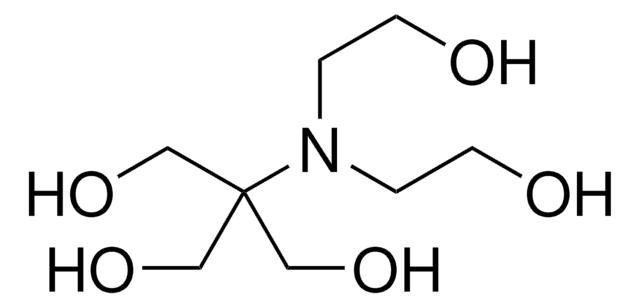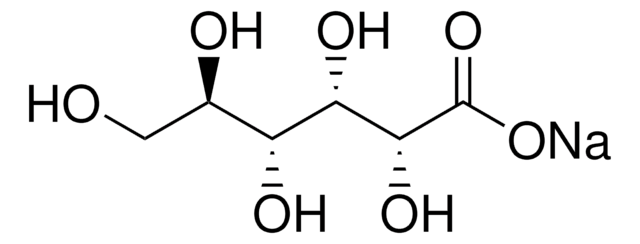T9784
Tricine
BioXtra, pH 4.0-6.0 (1 M in H2O), ≥99% (titration)
Sinónimos:
N-[Tris(hydroxymethyl)methyl]glycine
About This Item
Productos recomendados
product line
BioXtra
Quality Level
assay
≥99% (titration)
form
powder
impurities
≤0.005% Phosphorus (P)
≤0.1% Insoluble matter
ign. residue
≤0.1%
pH
4.0-6.0 (1 M in H2O)
useful pH range
7.4-8.8
pKa (25 °C)
8.1
solubility
H2O: 1 M, clear, colorless
anion traces
chloride (Cl-): ≤0.1%
sulfate (SO42-): ≤0.05%
cation traces
Al: ≤0.0005%
Ca: ≤0.0005%
Cu: ≤0.0005%
Fe: ≤0.0005%
K: ≤0.005%
Mg: ≤0.0005%
NH4+: ≤0.05%
Na: ≤0.005%
Pb: ≤0.001%
Zn: ≤0.0005%
absorption
≤0.05 at 280 in H2O at 1 M
≤0.1 at 260 in H2O at 1 M
application(s)
diagnostic assay manufacturing
SMILES string
OCC(CO)(CO)NCC(O)=O
InChI
1S/C6H13NO5/c8-2-6(3-9,4-10)7-1-5(11)12/h7-10H,1-4H2,(H,11,12)
InChI key
SEQKRHFRPICQDD-UHFFFAOYSA-N
¿Está buscando productos similares? Visita Guía de comparación de productos
General description
Application
- in a polymerase chain reaction (PCR) buffer used in the single-cell collection
- as a component of lactotroph feeding medium for culturing lactotrophs
- to prepare luciferase assay reagent for luciferase activity assay in firefly Photonis pyralis and as a component in Triton/glycylglycine lysis buffer
¿No encuentra el producto adecuado?
Pruebe nuestro Herramienta de selección de productos.
Storage Class
13 - Non Combustible Solids
wgk_germany
WGK 3
flash_point_f
Not applicable
flash_point_c
Not applicable
ppe
Eyeshields, Gloves, type N95 (US)
Certificados de análisis (COA)
Busque Certificados de análisis (COA) introduciendo el número de lote del producto. Los números de lote se encuentran en la etiqueta del producto después de las palabras «Lot» o «Batch»
¿Ya tiene este producto?
Encuentre la documentación para los productos que ha comprado recientemente en la Biblioteca de documentos.
Los clientes también vieron
Nuestro equipo de científicos tiene experiencia en todas las áreas de investigación: Ciencias de la vida, Ciencia de los materiales, Síntesis química, Cromatografía, Analítica y muchas otras.
Póngase en contacto con el Servicio técnico




